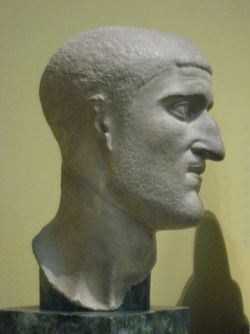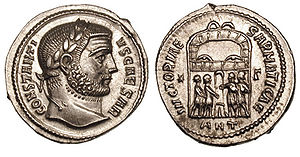Constantius Chlorus
| Constantius I | |
|---|---|
| Emperor of the Roman Empire | |
 |
|
| Reign | 293 – 305 (as Caesar with Maximian); 305 – 306 (as Augustus in the west, with Galerius as Augustus in the east) |
| Full name | Marcus Flavius Valerius Constantius |
| Born | 31 March c. 250 |
| Birthplace | Dardania (present-day Kosovo) |
| Died | 25 July 306 (aged 56) |
| Place of death | Eboracum, Britannia |
| Predecessor | Maximian (with Diocletian in the East) |
| Successor | Flavius Valerius Severus (with Galerius in the East) |
| Wives | Helena (?–293) Theodora (293–306) |
| Offspring | Constantine the Great Flavius Dalmatius Julius Constantius Flavia Julia Constantia Eutropia Anastasia |
| Dynasty | Constantinian |
| Father | Eutropius |
| Mother | Claudia |
Flavius Valerius Constantius[1] (c. 31 March 250 – 25 July 306), commonly known as Constantius I or Constantius Chlorus[2], was Roman Emperor from 293 to 306. He was the father of Constantine the Great and founder of the Constantinian dynasty.
Contents |
Early life
The Historia Augusta says Constantius was the son of Eutropius, a noble from northern Dardania in modern Kosovo, and Claudia, a niece of the emperors Claudius II and Quintillus.[3] Modern historians suspect this maternal connection to be a genealogical fabrication created by his son Constantine I. His father, however, might have been the brother of Eutropia, wife of Maximian.
Constantius was a member of the Protectores Augusti Nostri under emperor Aurelian and fought in the east against the secessionist Palmyrene Empire. Shortly after he attained the rank of tribunus within the army, and during the reign of Carus he was raised to the position of praeses, governor, of the province of Dalmatia.[4]
In 293 the emperor Diocletian created the Tetrarchy, dividing the Roman Empire into Western and Eastern portions. Each would be ruled by an Augustus, supported by a Caesar. Diocletian became Augustus of the Eastern empire, with Galerius as his Caesar. Constantius was appointed Caesar to the Western Augustus, Maximian, and married Theodora, Maximian's stepdaughter. They had six children. Constantius divorced his first wife (or concubine), Helena, by whom he already had a son, Constantine. Helena was probably from Nicomedia in Asia Minor.[5] He was given command of Gaul, Britain and possibly Hispania.

In 293, Constantius defeated the forces of Carausius, who had declared himself emperor in Britain and northern Gaul in 286, near Bononia. Carausius was killed by his rationalis Allectus, who took command of Britain until 296, when Constantius sent Asclepiodotus, a prefect of the Praetorian Guard, to invade the island. Allectus was defeated and killed, and Roman rule in Britain restored.[6]
Also in 296, Constantius fought a battle against the Alamanni at the city of Lingonae (Langres) in Gaul. He was shut up in the city, but was relieved by his army after six hours, and defeated the enemy.[7] He defeated them again at Vindonissa (Windisch, Switzerland),[8] thereby strengthening the defenses of the Rhine frontier.

Diocletian and Maximian stepped down as co-emperors in 305, possibly due to Diocletian's poor health, and the Caesars, Constantius and Galerius, became co-emperors. Constantius ruled the western empire, Galerius the eastern. Severus and Maximinus Daia were appointed Caesars. Constantine, who had hoped to be a Caesar, joined his father's campaigns in Gaul and Britain.[9] Constantius died in Britain, at Eboracum (York), in 306, and Constantine was declared emperor by the army.[10]
Legend
Christian legends
As the father of Constantine, a number of Christian legends have grown up around Constantius. Eusebius's Life of Constantine claims that Constantius was himself a Christian, although he pretended to be a pagan, and while Caesar under Diocletian, took no part in the emperor's persecutions.[11] His first wife, Helena, found the True Cross.
British legends
Constantius's activities in Britain were remembered in medieval British legend. According to Geoffrey of Monmouth's History of the Kings of Britain (1136), Constantius was sent to Britain by the Senate after Asclepiodotus, here a British king, was overthrown by Coel of Colchester. Coel submitted to Constantius and agreed to pay tribute to Rome, but died only eight days later. Constantius married Coel's daughter Helena and became king of Britain. He and Helena had a son, Constantine, who succeeded to the throne of Britain when his father died at York eleven years later.[12] The identification of Helena as British had previously been made by Henry of Huntingdon,[13] but has no historical validity: Constantius had divorced Helena before he went to Britain.
Notes
- ↑ "Marcus Flavius Valerius Constantius", "Valerius Constantius", "Gaius Valerius Constantius", and "Gaius Fabius Constantius" have been found on inscriptions
- ↑ From the Greek χλωρός, meaning pale/yellow-greenish
- ↑ Historia Augusta, Claudius 13
- ↑ Odahl, Charles Matson. Constantine and the Christian Empire. New York: Routledge, 2004. p.16
- ↑ Eutropius, Breviarum 9.22; Zosimus, Historia Nova 2; Exerpta Valesiana 1.2
- ↑ Aurelius Victor, Liber de Caesaribus, 39
- ↑ Eutropius, Breviarum 9.23
- ↑ UNRV History: Battle of the Third Century AD
- ↑ Eutropius, Breviarum 10.1; Aurelius Victor, Epitome de Caesaribus 39; Zosimus, Historia Nova 2
- ↑ Eutropius, Breviarum 10.1–2
- ↑ Eusebius, Vita Constantini 1.13–18
- ↑ Geoffrey of Monmouth, Historia Regum Britanniae 5.6
- ↑ Henry of Huntingdon, Historia Anglorum 1.37
External links
- DiMaio, Robert, "Constantius I Chlorus (305–306 A.D.)", DIR
- Constantius Chlorus on History of York website
 Media related to Constantius Chlorus at Wikimedia Commons
Media related to Constantius Chlorus at Wikimedia Commons- Constantius Chlorus
|
Constantius Chlorus
Constantinian dynasty
Born: 31 March 250 Died: 25 July 306 |
||
| Regnal titles | ||
|---|---|---|
| Preceded by Maximian (with Diocletian in the east) |
Roman Emperor Co-emperor with Galerius in the east 305 (Caesar from 293)–306 |
Succeeded by Flavius Valerius Severus (with Galerius in the east) |
| Preceded by Coel |
Legendary British Kings 305–306 |
Succeeded by Constantine |
| Political offices | ||
| Preceded by Diocletian , Maximian |
Consul of the Roman Empire 294 with Galerius |
Succeeded by Nummius Tuscus , Annius Anullinus |
| Preceded by Nummius Tuscus , Annius Anullinus |
Consul of the Roman Empire 296 with Diocletian |
Succeeded by Maximian , Galerius |
| Preceded by Diocletian , Maximian |
Consul of the Roman Empire 300 with Galerius |
Succeeded by Titus Flavius Postumius Titianus , Virius Nepotianus |
| Preceded by Titus Flavius Postumius Titianus , Virius Nepotianus |
Consul of the Roman Empire 302 with Galerius |
Succeeded by Diocletian , Maximian |
| Preceded by Diocletian , Maximian |
Consul of the Roman Empire 305–306 with Galerius |
Succeeded by Maximian , Constantine I , Flavius Valerius Severus, Maximinus Daia, Galerius |
|
|||||||||||||||||||||||